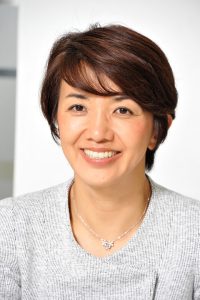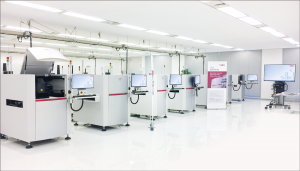EMSNOW Industry Executive Interview: Saki Corporation’s President, Sakie (Jodie) Akiyama
EMSNOW Industry Executive Interview: In honor of International Women in Engineering Week, we are pleased to spotlight AOI inspection system provider, Saki Corporation’s President, Sakie (Jodie) Akiyama:
EMSNOW: It was unusual for a woman to start an engineering company anywhere in the world in 1994, but I imagine it was infinitely more unusual in Japan. What is your background and how did you decide to start Saki?
 I graduated in 1987 from a university in Japan with a degree in law. It was a very historic time. The Japanese government had just passed a law, the Equal Employment Act. Before that, job opportunities for women were limited to just the typical more administrative, teaching, or nursing roles. Recruiting was separate for women and men. With the new law, large Japanese companies had to start recruiting men and women together. They still weren’t equal, but more jobs were available. I am the first generation under that law. I attended many recruiting events, but even though the law said there had to be equality, I could tell that changing someone’s mindset would take a lot more time. Instead of working for a Japanese company, I decided to work as a business consultant for the American accounting firm, Arthur Andersen, now called Accenture.
I graduated in 1987 from a university in Japan with a degree in law. It was a very historic time. The Japanese government had just passed a law, the Equal Employment Act. Before that, job opportunities for women were limited to just the typical more administrative, teaching, or nursing roles. Recruiting was separate for women and men. With the new law, large Japanese companies had to start recruiting men and women together. They still weren’t equal, but more jobs were available. I am the first generation under that law. I attended many recruiting events, but even though the law said there had to be equality, I could tell that changing someone’s mindset would take a lot more time. Instead of working for a Japanese company, I decided to work as a business consultant for the American accounting firm, Arthur Andersen, now called Accenture.
Most of the women from my graduating class didn’t continue with their careers. The pressures of society for women to be wives and mothers, fulfill the typical role of the Japanese woman, or to compete in the marketplace were too great. Some dropped out immediately, some when they got married, had children, or had to care for aging family members, and some because their husband’s parents didn’t want their sons married to a career woman. I was one of the few to pursue my career, but there were many challenges. I had to sacrifice having a family and had no one to serve as a mentor or role-model for starting or running a major company. I’ve had to figure it out on my own along the way. Fortunately, my husband, Yoshihiro Akiyama, was very supportive, but even then, with two careers, someone had to compromise. He was working as an engineer for Panasonic. I was working on many projects and was asked to join a project in another city. I realized that the only way to have a career and maintain a marriage was if we started our own business and worked together. Akiyama-san agreed.
I had no background in engineering, but I saw Akiyama-san and all his colleagues and how hard they worked. At that level, there were many talented engineers with many innovative ideas for products, but in large companies, only a few of the ideas could reach the market or benefit society. With all this enthusiasm, energy, and passion, their ideas were getting lost. We wanted to contribute to society with the technology that we invented.
EMSNOW: How did you start your company and what made you choose an inspection company as your business?
Saki was started to solve the challenge of SMT inspection in electronics manufacturing. Our first order was from Sony. They had invented the Sony Walkman, the first hand-held, lightweight, portable audio cassette player so people could listen to music any time and wherever they were. Until then, cassette players were large, notebook-sized players weighing a minimum of 5 pounds. The Walkman was a revolutionary concept. It was very small. So, what happened to the circuit board? It now contained very small components with high density placement. The Sony factory that manufactured the Walkman had a cutting-edge challenge. They couldn’t find a good solution for inspection.
Many Japanese companies offered visual inspection. They were all large companies, but no one could fill the solution for Walkman. I came to know the situation and had a good relationship with Sony, so I introduced them to Akiyama-san. He was able to develop a prototype for an AOI (automated optical inspection) machine that could operate through Microsoft Windows. Before that, everyone’s machine was MS-DOS. Inspection was especially important because the pick-and-place machines hadn’t evolved to do accurate placement in a high-throughput environment. We had no funding, just a simple prototype. Akiyama-san brought it to Sony and spent many months at the Sony site working on it and developing the functionality. Finally, Sony put the machine in the line and could see that it could improve line quality. When we got to that point, I asked them if they intended to order the machine, and we got our first machine order. Following the Walkman, computers became smaller and the mobile phone came into existence, so Saki’s next customer made notebook PCs and mobile phones. That was followed by a Taiwanese EMS company that had the order from Apple for notebooks and mobile phones. So, we learned how to be successful in the field.
EMSNOW: Because of your experience, I know that being a mentor for other women in high technology must be very important to you, as is working with the Japanese government to implement changes in government and the workplace. How are you working to accomplish that?
It’s important to me to give back to the community and lead a path for the next generation of women. 15 years ago, I was appointed as a member of a committee which reports directly to the Prime Minister of Japan. I was the youngest member. I was involved with one of the committees that established how Japan should organize new industries. 5 years ago, I was appointed to a committee from the private sector that reported directly to Prime Minister Abe. There were only 10 selected. I was the only woman. My term has expired, but I continue to be involved on several Japanese government committees and deliver proposals and position statements on topics. As much as I would like to just focus on my business, I feel it’s the mission of women of my generation to open more opportunities for women today.
EMSNOW: Much greater collaboration among the equipment vendors is required to facilitate M2M connectivity. What about the adoption of M2M on the factory floor? How is that going?
 Inspection is becoming even more important. The number of people working in factories in decreasing and automation is a necessity. Whereas in the past, the role of inspection equipment was purely to inspect, now it must measure and provide analytical results. Inspection equipment will act as a sentry for the assembly process and become a preventive machine tool for the entire line. In this role, accurate and reliable inspection and measurement results are critical.
Inspection is becoming even more important. The number of people working in factories in decreasing and automation is a necessity. Whereas in the past, the role of inspection equipment was purely to inspect, now it must measure and provide analytical results. Inspection equipment will act as a sentry for the assembly process and become a preventive machine tool for the entire line. In this role, accurate and reliable inspection and measurement results are critical.
Inspection equipment plays a major role in the assembly manufacturing process, especially in the automotive and communications markets where reliability has become mandated. In an assembly line, the SPI (solder paste inspection) machine feeds back to the printer and forward to the pick-and-place system and the AOI feeds back to the pick-and-place machine. Since the major pick-and-place manufacturers are driving much of the M2M initiatives, inspection systems play an integral part in M2M communication.
Business is dramatically changing. Before Industry 4.0, companies could focus on improving their machines. Saki’s mission has always been to create new value and to be the cutting-edge solution provider, but now, we can’t just focus on our inspection systems, but on the whole production line and how our systems can contribute and connect to other machines, the cloud, and big data. Its’s not only us. We have to be good partners. So, our outlook is broader, and the focus is on more value-added. It starts with hardware and then we add value with the development of software, but now we must do more and create new value. Technology development can’t skip a step. We keep trying to improve ourselves and make sure that innovation is also a value to society.
Saki has established relationships with many of the leading companies in the electronics assembly industry, especially pick-and-place and screen printer equipment manufacturers. Saki was the first company to be able to implement a feed-back feature from pre-reflow AOI to the pick-and-place machine. Saki has received Panasonic certification and partners with Fuji Machine Manufacturing’s Smart Factory with Nexim initiative, the ASYS PULSE Community, and others. We take a proactive approach to standardization and adhere to standards set forth by the SMT equipment communication protocol standardization subcommittee (JARA) as well as the Hermes Standard, which focuses on Industry 4.0.
EMSNOW: So how has the business world changed for women in Japan?
Today women have more options, and they are taking them. Household responsibilities and childcare are now shared more between husband and wife and it is more common to see the woman with the career and the man staying home with the children. Laws have made it easier for women to have careers. Especially now, with the birthrate down in Japan, the Japanese government realizes that it will need more workers, so they are encouraging women to work. More women are taking higher level positions, but it’s still a beginning. I think there will always be some type of trade-off between a career and family.
EMSNOW: What is your vision for Saki and yourself for the future?
This is a very exciting time for Saki. We have approximately 10,000 machines installed in more than 50 countries. In April we’ll celebrate Saki’s 25th anniversary in business. With all the growth, development, and our new generation of products and innovations I feel like we’re being reborn. Saki became a group company of DMG Mori two years ago, so we are stronger than ever. We just moved into new, modern facilities in Tokyo, Japan and also in Fremont, California and Seoul, Korea, and we’re planning moves in other regions into expanded facilities with plenty of room for research and development and demonstration areas. We are hiring new employees and expanding our rep and distributor networks, plus, we have quite a few new products we’re ready to introduce.
 On a personal note, when I faced a difficult time in business in 2008, I decided to start running. Since then, I’ve completed a marathon every year. Just as Saki strives to reach new milestones, I’ve achieved my personal record, running this year’s TOKYO marathon.
On a personal note, when I faced a difficult time in business in 2008, I decided to start running. Since then, I’ve completed a marathon every year. Just as Saki strives to reach new milestones, I’ve achieved my personal record, running this year’s TOKYO marathon.













